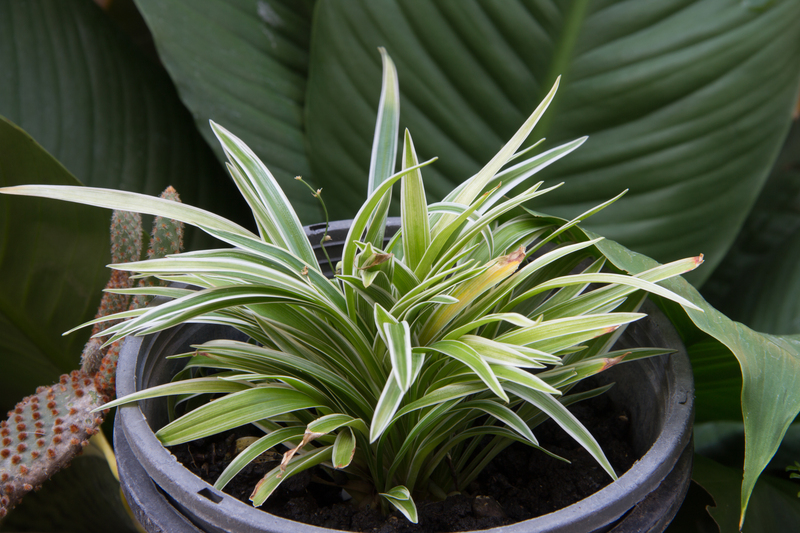Organic Waste: Cultivating Growth and Fertility
Posted on 27/05/2025
Organic Waste: Cultivating Growth and Fertility
Organic waste is often considered a problem, contributing to landfills and rising greenhouse gas emissions. But when managed correctly, organic waste becomes a valuable asset for cultivating growth and fertility in gardens, farms, and ecosystems. This article provides a comprehensive look at how recycling organic matter can transform the way we nurture plants, restore soil health, and create sustainable cycles for future generations.
Understanding Organic Waste
Organic waste refers to biodegradable material originating from plants or animals. This includes:
- Food scraps
- Yard trimmings (grass, leaves, branches)
- Paper products
- Manure
- Wood chips and sawdust
- Agricultural residues
Unlike inorganic waste, such as plastics or metals, organic materials are capable of decomposing naturally. By returning these resources to the earth, we not only reduce landfill mass but also contribute to soil fertility and promote plant growth.
Why Is Organic Waste Important?
The average household throws away a significant amount of organic matter every year. According to the Environmental Protection Agency (EPA), food and yard waste constitute about 30% of what we discard. By diverting this material from landfills and recycling it through composting or other means, we create a closed-loop system that supports healthier soils and plants.

Decomposition: Nature's Recycling System
Decomposition is the process by which organic waste is broken down by microorganisms such as bacteria, fungi, and earthworms. This natural cycle is essential for:
- Releasing nutrients such as nitrogen, phosphorus, and potassium
- Building soil structure and fertility
- Improving moisture retention and aeration
- Suppressing soil-borne diseases and pests
By harnessing the power of decomposition, we convert "waste" into a resource for cultivating growth and soil fertility.
The Benefits of Recycling Organic Waste
1. Enhanced Soil Fertility and Structure
When you add organic waste to the soil in the form of compost or mulch, it acts as a slow-release fertilizer. This improves nutrient content and creates a porous soil structure that allows roots to access water, oxygen, and minerals more easily.
- Compost: Rich in nutrients and beneficial microbes.
- Mulch: Protects soil, conserves moisture, and regulates temperature.
- Manure: Supplies essential nutrients and organic matter.
2. Sustainable Plant Growth and Yields
Composted organic material supports healthy plant growth without the need for synthetic fertilizers. Crops grown with enriched soils often produce higher yields and are more resilient to pests and diseases.
3. Reducing Landfill Waste & Carbon Emissions
When organic matter decomposes anaerobically (without oxygen) in landfills, it releases methane--a potent greenhouse gas. By composting at home or on a larger scale, we can significantly reduce methane emissions and create carbon-rich soil that sequesters atmospheric carbon.
4. Water Conservation
Healthy, well-structured soils enriched with biodegradable waste can hold up to 20 times their own weight in water. This means less runoff, reduced irrigation needs, and more resilient landscapes during droughts.
Methods of Recycling Organic Waste
Composting
Composting is the most common way to recycle organic residues. Through either aerobic (with oxygen) or anaerobic (without oxygen) processes, composting transforms waste into a nutrient-rich soil amendment. There are several ways to compost:
- Backyard composting: Ideal for household food and yard waste. Simply pile organic materials in a bin or heap, keep it moist, and turn regularly to add oxygen.
- Vermicomposting: Using earthworms to break down food scraps quickly, producing a high-quality fertilizer known as worm castings.
- Community composting: Shared composting initiatives in neighborhoods, schools, or community gardens.
- Industrial composting: Large-scale facilities handling municipal organic waste and producing commercial compost products.
Mulching
Mulching involves spreading organic materials--such as grass clippings, leaves, or wood chips--over the soil surface. Over time, the mulch breaks down, feeding the soil and suppressing weeds.
Bokashi (Fermentation)
Bokashi is a form of anaerobic fermentation using beneficial microbes to quickly ferment kitchen scraps. The resulting material can be buried in the garden to enrich the soil directly.
Biochar
Biochar is produced by heating organic material in a low-oxygen environment (pyrolysis). It is highly stable and acts as a soil enhancer by improving nutrient retention and microbial activity.
The Science Behind Soil Fertility
Soil fertility is determined by three core factors:
- Nutrient Content: The amount of essential plant nutrients, such as nitrogen, phosphorus, and potassium.
- Soil Structure: Well-aggregated soils with plenty of pore space for water and air.
- Organic Matter: The engine driving soil microbial life and chemical interactions.
Adding decomposed organic waste to the soil supports a robust ecosystem of earthworms, bacteria, fungi, and arthropods that, in turn, convert complex organic compounds into forms plants can use. This virtuous cycle is the foundation of natural plant growth and fertility.
Soil Health and Microbial Life
When we talk about soil fertility, it's impossible to ignore the invisible community below our feet. Healthy soils teem with billions of microbes within a single handful. These organisms help:
- Break down organic matter into humus
- Convert nitrogen into plant-available forms
- Suppress soil pathogens
- Facilitate nutrient uptake
- Create soil aggregates that improve structure and aeration
Regular addition of organic residues ensures a continuous supply of food for these beneficial organisms, keeping the soil healthy and productive.
Organic Waste Management in Agriculture
In modern agriculture, managing farm organic waste effectively is crucial for sustainability and profitability. Techniques include:
- Plowing crop residues back into the land
- Using cover crops and green manures
- Utilizing animal manure as fertilizer
- Adopting precision composting systems
- Converting food processing byproducts into soil amendments
These approaches close nutrient loops, boost crop yields, and reduce reliance on synthetic fertilizers, making farming more environmentally friendly
Manure Management
Livestock manure is a potent source of nutrients, but improper handling can lead to pollution. Composting manure or using it in biogas digesters not only reduces odor and pathogens but also produces valuable soil amendments and renewable energy.
Home Composting: Steps to Get Started
If you want to cultivate growth and soil fertility in your own backyard, home composting is a simple and rewarding way to recycle kitchen and yard scraps.
Step-by-Step Composting Guide:
- Choose Your Spot: Find a level location with good drainage and partial shade.
- Set Up a Compost Bin: Use a store-bought bin or build your own with pallets or wire mesh.
- Add Materials:
- - Browns (carbon-rich): Dried leaves, cardboard, paper, straw
- - Greens (nitrogen-rich): Fruit and vegetable scraps, grass clippings, coffee grounds
- Maintain Balance: Aim for a roughly equal mix of browns and greens, and keep the pile moist but not wet.
- Aerate: Turn the pile every 1-2 weeks to add oxygen and speed up decomposition.
- Harvest: Within 2-6 months, your compost will be dark, crumbly, and earthy-smelling. Use it to nourish gardens, lawns, or houseplants.
Common Challenges and Solutions
Odor Issues
Strong smells usually result from too much moisture or excess green material. Fix this by:
- Adding more browns (dry leaves, shredded paper)
- Turning the pile more often
- Avoiding meat, dairy, or oily foods
Pests
To prevent rodents and flies, always bury food scraps under a layer of browns, and avoid adding cooked foods or animal products.
Slow Composting
Cold piles or slow decomposition can be jump-started by chopping materials smaller, maintaining the right moisture level, and adding more greens to boost nitrogen.
Other Ways to Recycle Organic Waste
Community Waste Programs
Many cities offer curbside organic waste collection for composting at municipal facilities. The finished compost is often used in parks, gardens, and landscaping.
Animal Feed
Certain food scraps are suitable for livestock feed, reducing waste and closing the loop on food production systems.
Bioenergy Production
Anaerobic digestion systems convert organic matter into biogas, which can power farms, produce electricity, and supply clean energy to communities.

Organic Waste and Sustainable Development
Recycling organic matter plays a pivotal role in achieving the United Nations' Sustainable Development Goals (SDGs), including:
- Zero Hunger: Improving soil fertility boosts food production.
- Clean Water: Healthy soils retain more water and use fertilizers more efficiently.
- Climate Action: Preventing methane emissions and storing carbon in soils.
- Responsible Consumption and Production: Reducing waste and promoting circular economies.
The Circular Economy
In a circular economy, materials are kept in use for as long as possible. Composting and recycling organic residues turn linear waste streams into regenerative cycles that benefit both people and the planet.
Conclusion: Harnessing Organic Waste for a Fertile Future
Organic waste is not just garbage--it is a vital resource for cultivating growth and fertility across agricultural fields, community gardens, and even urban balconies. By adopting composting, mulching, and other recycling strategies, we can transform kitchen scraps and yard debris into black gold that nurtures soil, conserves water, cuts greenhouse gas emissions, and helps feed a growing world. As we move towards more sustainable lifestyles, understanding and utilizing the power of organic materials is essential for creating healthy, resilient food systems and a greener future for all.
Start today by recycling your own organic waste, and become part of a movement that transforms 'waste' into endless growth and fertility.

